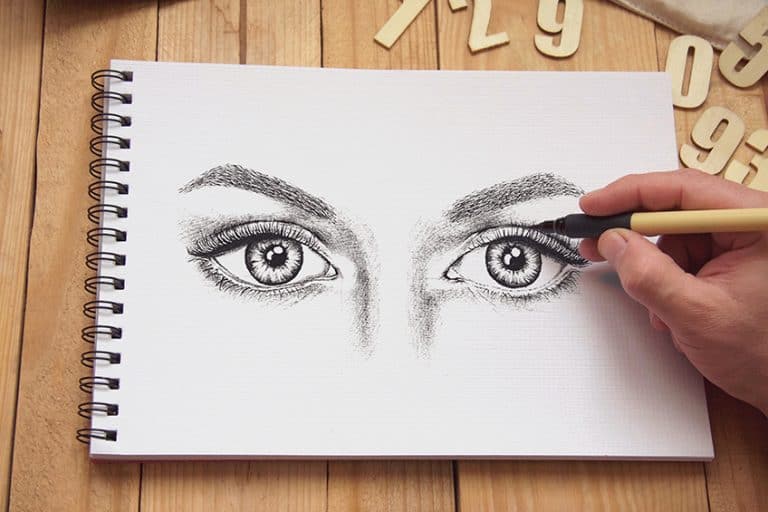How to Draw a Goat – Learning the Ins and Outs of Goat Drawing with us
Mischievous and playful creatures, goats are some of the most fun-loving animals in the farmyard. With their wiry hair, big curvey horns, and goatee, goats are instantly recognizable. This signature style can make it difficult to create a realistic drawing of a goat because the smallest mistake may be picked up on quickly. Do not let that fear stop you! In this guided tutorial, we take you through all the steps and give you our top tips and tricks to help you easily create a realistic goat drawing in no time.
How to Draw and Paint a Realistic Goat the Easy Way!
Often when drawing animals like a goat, the hardest part is knowing where to start. If this sounds like you, then you have come to the right place. In our goat drawing tutorial, we show you the best way to lay down the shape of your goat sketch before moving on to adding details and colors. As you can see in the outline of the tutorial below, we begin our drawing of a goat by using a series of construction shapes and lines. This construction process helps us to get the correct dimensions and proportions in our drawing.
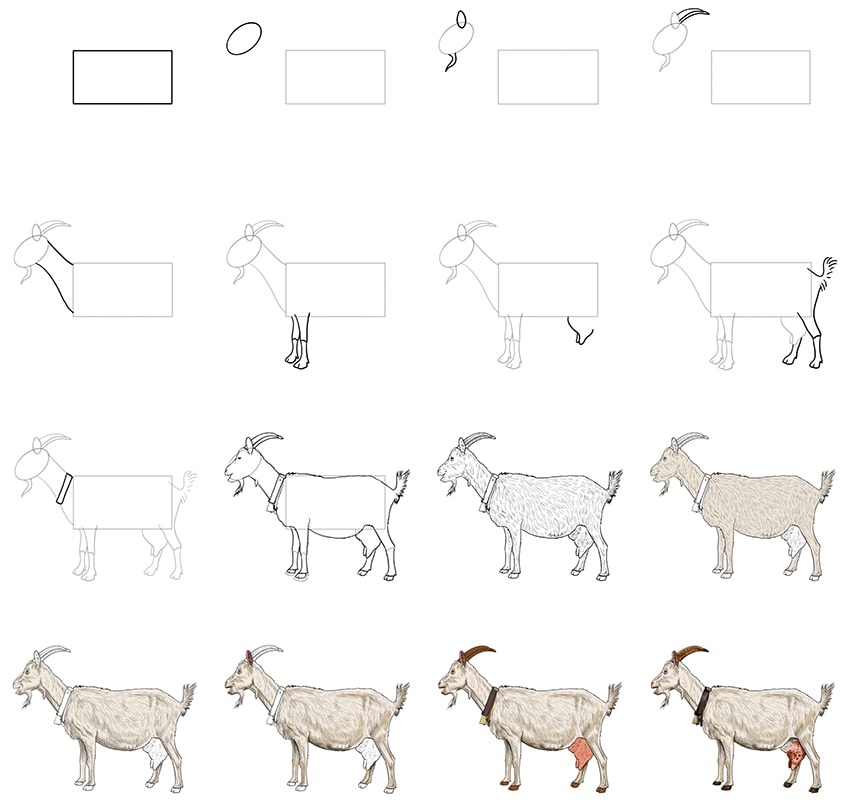
When it comes to the materials you use to create your own drawing of a goat, there are countless options. If you are a graphic artist, you can easily follow this tutorial on your drawing tablet. If you prefer to use pastels or paint, it is simple to modify the coloring steps to suit your needs.
With that said, gather up your drawing supplies, get comfortable, and let us get into the drawing tutorial!
Step 1: Laying Down the Shape of the Body
Most of our other drawing tutorials begin with an oval shape to represent the main part of the animal’s body, but for our goat, we are using a large rectangle. Draw a horizontally laying rectangle at the center of your canvas.
Our top tip for this first step is to ensure that you leave a good deal of space on all sides of your rectangle for all the other limbs of your goat drawing.

Step 2: Constructing the Goat’s Head
To lay down the shape of the goat’s head, you are going to use a small and narrow oval shape. Some way away from the top left corner of the main body rectangle, draw this oval slightly angled with the bottom towards the lower right corner of your canvas.

Step 3: Drawing the Shape of the Beard and Ear
It is time to construct the shape of that signature billy-goat beard and the ear of your easy goat drawing. For the beard, draw a little squiggly shape from the bottom of the head oval. For the ear, draw a small vertical oval on the top of the head oval.
From our perspective, only one of the goat’s ears is visible as the other is hidden by the horns.

Step 4: Crafting the Horns of Your Goat
This is a very simple step, and it is the last piece of construction we will be doing on the head of your goat. Simply draw two horn shapes behind the ear construction shape.
Thanks to our perspective, the lower horn, which is the one furthest away from us, is partially hidden by the other. Make sure that you capture this difference to uphold the correct perspective in your drawing of a goat.

Step 5: Using the Neck to Connect the Body and Head
It is now time to join the head and body together. To do this, we are going to use two necklines that connect to the left corners of the main body rectangle. Begin with the top neckline, drawing an ever-so-slightly curved line from the top point of the head oval to the top left corner of the body rectangle.
Begin the bottom neckline just a little behind the beard shape and curve it down to join the bottom left corner.

Step 6: Drawing the Goat’s Front Legs
In this step, you are going to draw in the two front legs of your goat drawing. Begin with the leg that is closest to our perspective. Use two lines that begin within the body rectangle and curve slightly towards each other as they extend down towards the ground. Use a short curved line to separate this thigh shape from the ankle and hoof, and then create a thinner ankle that moves seamlessly into the hoof. You can repeat the same process for the second leg.
Once again, it is always a good idea to keep perspective in mind, as the furthest leg will appear shorter and thinner than the closer one, and it will also be partially hidden by the front one.

Step 7: Crafting the Shape of the Udder
Before we move on to draw in the two back legs, we are going to outline the shape of the udder. Begin drawing the udder about a third of the way from the back of the main body rectangle. Curve this line down and back, before creating the shape of a teet and then curving back up slightly. Draw another small teet shape just in front of this one.
Do not take the back line of the udder all the way up to the main body rectangle again. The legs are going to be hiding this part of the udder.

Step 8: Drawing the Goat’s Tail and Back Legs
This step involves a range of different things, but by the end of it, your goat should start becoming visible. Begin by drawing the back leg closest to our perspective, starting the line within the main body oval and taking it down and backward. After the joint, the leg can extend downward a more and end it with the hoof shape. As you go back up the other side of the leg, curve it up behind the back of the rectangle and then draw the tail with some small curved lines.
For the second leg, simply draw the bottom half of it poking forward from below the udder.
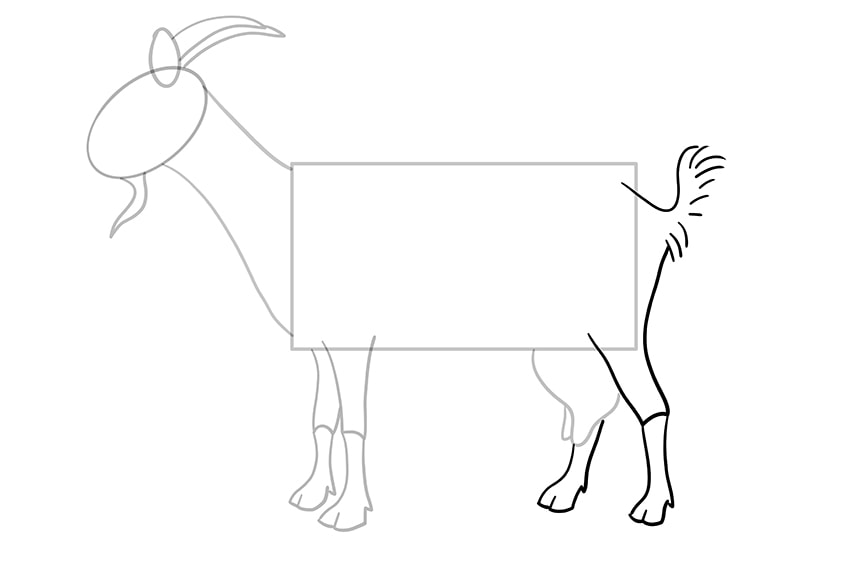
Step 9: Outlining the Goat’s Collar
This last step before we create the final outline of our easy goat drawing involves drawing the collar around the goat’s neck. Simply draw a collar strip along the neck.
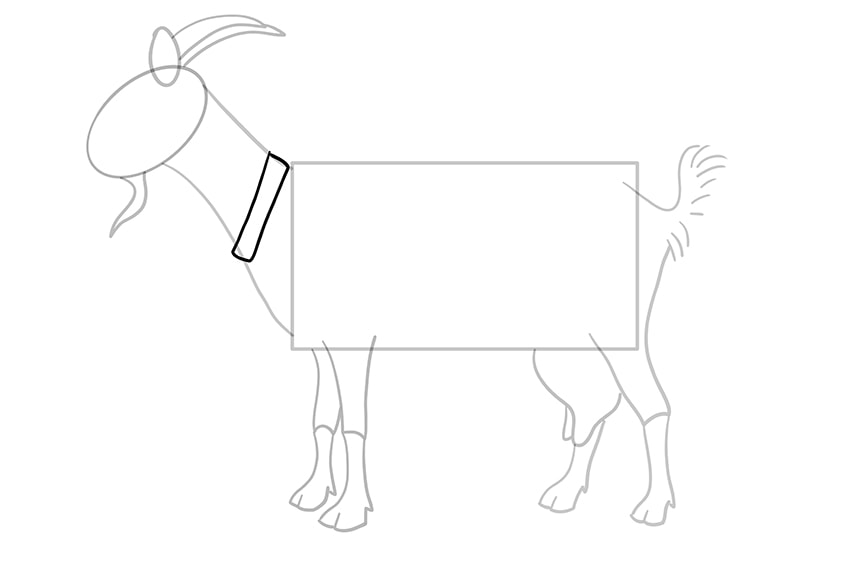
Step 10: Drawing the Final Outline of Your Goat
It has finally come time to use all of your construction lines to help you create the final outline of your easy goat drawing. Begin at the head, using the oval to guide your pencil as you create the shape of the nose, mouth, and forehead. Create the separation of the mouth and add some additional facial details including an eye and a nostril. For the beard, you can use some short feathery strokes at the end of the shape to create the impression of fur. Outline the ears and the horns, and then continue onto the neck, creating a detailed outline of the color with a bell on the end.
Continue to outline the rest of the goat’s body, adding curves and bulges to the body so that it appears more natural and not rectangular like the construction shape.
For the outline of the main body, you can use very short strokes to create a sense of a fur coat. All these little lines should face towards the back of the goat’s body. Just as you used hair strokes on the beard, you can do the same for the tail, fleshing it out a little more. When you get to the udder and legs, you can revert to smooth lines and follow the construction shapes very closely. Add a little furry line above the hooves to separate them from the rest of the legs.
When you are happy with your final outline, you can erase any of the remaining construction lines that are visible.
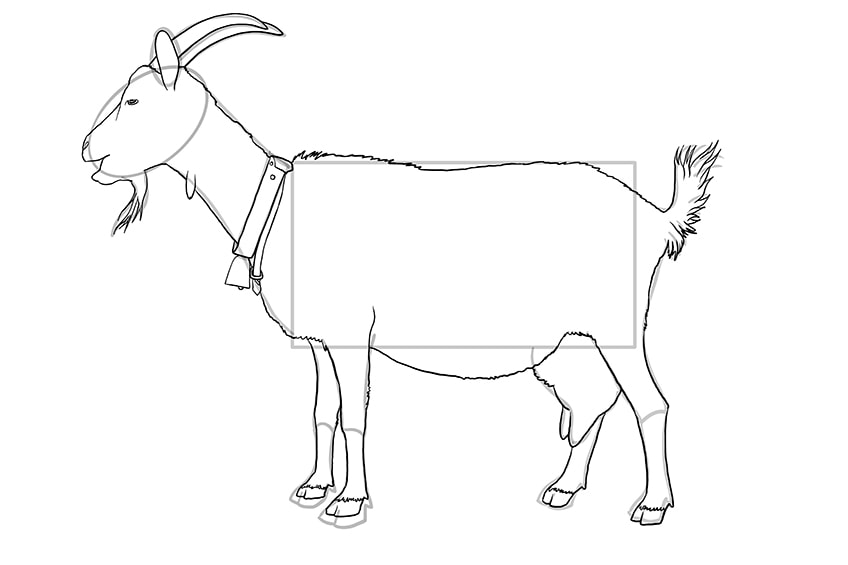
Step 11: Adding Textural Details
Now that we have our outline in place, it is time to add some textural details throughout the body of your goat drawing. Begin at the head, adding short little lines within both of the horns. You can then begin adding a combination of short and long lines throughout the face to add fur texture.
For the hair throughout the body of your goat, the best way to make it as realistic as possible is to follow the curves of the body.
Continue adding hairlines down the goat’s neck and body, making the hairs gradually longer as you get further down the body. For the udder, draw a few slightly differently sized circles. Leave the hooves bare.

Step 12: Adding the First Layer of Color
We always make sure to create the most natural coloring for our drawings by layering up different shades. For our goat drawing, we are going to begin with a light shade of beige. Use a soft brush and distribute the color evenly throughout the head and body of your goat.
Remember in this step to leave the horns, collar, udder, and hooves blank as they will be different colors.

Step 13: Using A Touch of Black for Shading
Now we are going to add a little shading and dimension to the body of your goat with a touch of back paint. Use this shading color to carve out the features of the face, neck, and body by emphasizing the points where the light would naturally not hit. These areas include under the belly, on the underside of the neck, between the legs, and around the nose.
Remember that it is very easy to overdo black, so take it easy. You can always add more, but you cannot take it away once it is on your canvas.

Step 14: Coloring the Details
In this step, you are going to use a couple of different colors to emphasize some details in your goat drawing. Begin with a light brown shade and add patches of brown throughout the body of your goat. Remember to do this lightly and blend the brown into the colors around it. Next, take a slightly darker shade of brown and use this to color in the ears of your goat and the inside of the nostrils, eyes, and mouth.
Finish this step by using a touch of white to add highlights to the patches of color and making sure that all of your colors are smoothly blended together.

Step 15: Adding Some More Color Details
In this step, we are going to color the horns, hooves, udder, and color of your goat. Begin by using a sharp brush to color the horns with an even shade of dark brown. You can use this same dark brown shade to color the hooves and part of the collar. Finish using this shade to color in the goat’s eye. Next, use the same sharp brush and a shade of light gray to paint the buckle of the collar, and use a darker shade of gray to fill in the rest of the collar. Finish off the collar by using some light gold or yellow paint to color in the bell.
To finish this step, use a peach shade to fill in the goat’s udder.

Step 16: Finalizing Your Shadows and Highlights
For the second last step, begin by using some dark brown paint and a fine brush to color in the spots on the udder. While you are busy with the udder, use a touch of white paint to add a touch of highlight around the spots, and then use some black to shade around the edges of the udder. For the collar, begin by using some black and a soft brush to add some shading along the belt and the bell. Continue to use black to shade the hooves. As the last step, you can use a fine brush to add some white highlights between the lines on the horns.
To make the shading and highlighting as smooth as possible, dab the brush gently and then use a dry brush to blend it out.
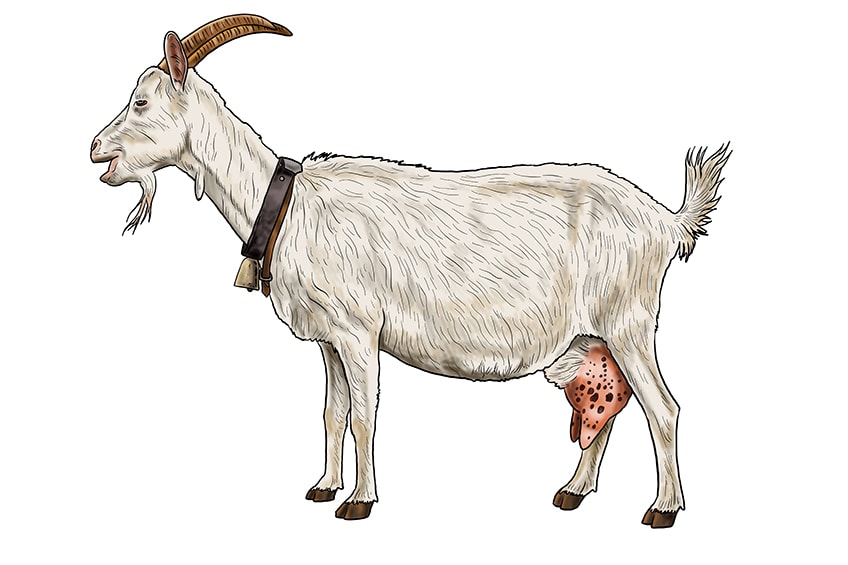
Step 17: The Finishing Touches
This step is optional for those wanting a final result that does not include the outline. To achieve this look, simply erase the outline or trace it with the corresponding color using a fine sharp brush. For an even more seamless look, trace the textural details with their corresponding colors too.

We hope you have thoroughly enjoyed our easy goat drawing tutorial, and that you now feel confident creating a range of different goat drawings. Now that you know all the tips and tricks, you can easily create a range of different animal drawings.
Video Tutorial on How to Draw a Goat
Frequently Asked Questions
Is It Hard to Create Goat Drawings?
Not at all. In fact, with our easy-to-follow goat drawing tutorial, we make it simple to create a beautiful and realistic goat drawing. If you have ever wanted to know how to draw a goat, you have come to the right place.
Can You Use the Same Principles to Draw Other Animals?
All the tips and tricks we outline in this tutorial can help you draw a range of different animals. The construction lines are the best way to get the proportions and perspectives spot on.
Matthew Matthysen is an educated multidisciplinary artist and illustrator. He successfully completed his art degree at the University of Witwatersrand in South Africa, majoring in art history and contemporary drawing. The focus of his thesis was to explore the philosophical implications of the macro and micro-universe on the human experience. Matthew uses diverse media, such as written and hands-on components, to explore various approaches that are on the border between philosophy and science.
Matthew organized various exhibitions before and during his years as a student and is still passionate about doing so today. He currently works as a freelance artist and writer in various fields. He also has a permanent position at a renowned online gallery (ArtGazette) where he produces various works on commission. As a freelance artist, he creates several series and successfully sells them to galleries and collectors. He loves to use his work and skills in various fields of interest.
Matthew has been creating drawing and painting tutorials since the relaunch in 2020. Through his involvement with artincontext.org, he has been able to deepen his knowledge of various painting mediums. For example, watercolor techniques, calligraphy and lately digital drawing, which is becoming more and more popular.
Learn more about Matthew Matthysen and the Art in Context Team.






